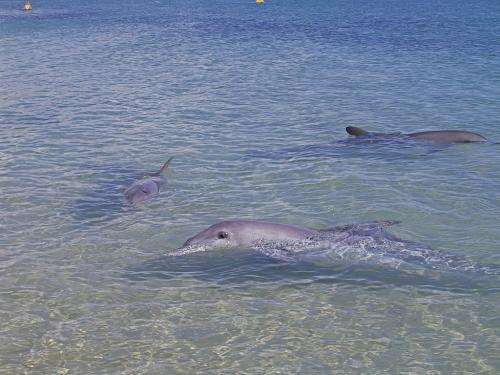New variant of cetacean morbillivirus identified in WA dolphins

Indo-Pacific bottlenose dolphin deaths in WA have been linked to a new variant of cetacean morbillivirus (CeMV)—a virus related to the human measles and canine distemper viruses, according to research from the Murdoch University Cetacean Research Unit (MUCRU).
The discovery follows post-mortem testing on two of three dolphins that died in the Swan River in June 2009, which concluded the animals died from opportunistic infections taking advantage of chronic immune system suppression caused by CeMV.
MUCRU's Dr Nahiid Stephens says identification and sequencing of the virus' N and P genes has revealed the new variant to be more closely related to similar viruses that infect land mammals than strains of CeMV discovered to date.
"Genetically speaking, we know that the WA virus differs significantly from previously discovered strains, but we don't yet know what that means in terms of its biological behaviour—for example, whether its genetic differences mean it is more infectious or more dangerous than the previously encountered strains of CeMV," Dr Stephens says.
Dr Stephens says CeMV has caused outbreaks in multiple cetacean species globally – such as pilot whales, dolphins and porpoises – predominantly in the Northern Hemisphere, and is now regarded as an emerging disease in Australian waters.
Increase in virus detection noted
While the first reported case was the 2010 death of a bottlenose dolphin in Queensland, the WA Swan River deaths now pre-date that event, and CeMV has since been identified in the deaths of multiple dolphins in South Australia in 2012 and 2013.
"We know from the global literature that CeMV cases in the Southern Hemisphere have historically been rare, but we've been seeing more reports in the last 12 to 18 months," Dr Stephens says.
"Prior to 2010, we had no reports of CeMV in Australian waters, and now we have a timeline of clinical cases going back to 2009. We're starting to see a pattern.
"The reality is that very little is known about the prevalence and pathogenicity of CeMV in the Indian Ocean and other regions in the Southern Hemisphere—could the apparent increase in case frequency simply be due to the fact that we're looking more closely now?
"Or have there been changes to host range so that animals that have not been previously exposed to the virus are coming into contact with it?"
The article cites literature which warns infection could become endemic, with periodic outbreaks in populations lacking immunity resulting in mortalities.
Provided by Science Network WA



















